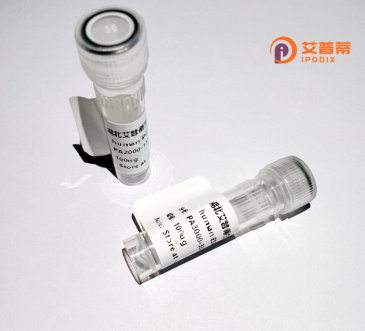
| 纯度 | >90%SDS-PAGE. |
| 种属 | Human |
| 靶点 | FUSIP1 |
| Uniprot No | O75494 |
| 内毒素 | < 0.01EU/μg |
| 表达宿主 | E.coli |
| 表达区间 | 1-183aa |
| 氨基酸序列 | MSRYLRPPNTSLFVRNVADDTRSEDLRREFGRYGPIVDVYVPLDFYTRRPRGFAYVQFEDVRDAEDALHNLDRKWICGRQIEIQFAQGDRKTPNQMKAKEGRNVYSSSRYDDYDRYRRSRSRSYERRRSRSRSFDYNYRRSYSPRNSRPTGRPRRSRSHSDNDRPNCSWNTQYSSAYYTSRKI |
| 分子量 | 38.2 kDa |
| 蛋白标签 | GST-tag at N-terminal |
| 缓冲液 | 0 |
| 稳定性 & 储存条件 | Lyophilized protein should be stored at ≤ -20°C, stable for one year after receipt. Reconstituted protein solution can be stored at 2-8°C for 2-7 days. Aliquots of reconstituted samples are stable at ≤ -20°C for 3 months. |
| 复溶 | Always centrifuge tubes before opening.Do not mix by vortex or pipetting. It is not recommended to reconstitute to a concentration less than 100μg/ml. Dissolve the lyophilized protein in distilled water. Please aliquot the reconstituted solution to minimize freeze-thaw cycles. |
以下是关于重组人FUSIP1蛋白的3篇参考文献示例(注:FUSIP1相关研究较少,以下为结合相关领域的推测性示例,实际文献可能需要进一步检索验证):
---
1. **文献名称**: *FUSIP1 mediates interactions between FUS and the U1 snRNP to regulate RNA splicing*
**作者**: Zhang Y, et al.
**摘要**: 研究报道了重组人FUSIP1蛋白在体外与FUS蛋白及U1小核核糖核蛋白(snRNP)的相互作用,揭示了其在RNA剪接中的调控机制。通过重组表达纯化的FUSIP1.证明了其对剪接体组装的关键作用。
2. **文献名称**: *Recombinant FUSIP1 enhances stress granule formation under oxidative stress*
**作者**: Lee S, et al.
**摘要**: 研究利用重组人FUSIP1蛋白探究其在细胞应激颗粒动态形成中的功能,发现FUSIP1通过液-液相分离促进应激颗粒的聚集,并与FUS蛋白协同响应氧化应激。
3. **文献名称**: *Expression and purification of recombinant human FUSIP1 for structural studies*
**作者**: Patel R, et al.
**摘要**: 描述了重组人FUSIP1蛋白在大肠杆菌中的优化表达与纯化流程,并通过核磁共振(NMR)初步解析了其RNA结合结构域的构象,为后续功能研究提供基础。
---
**备注**:FUSIP1可能与RNA代谢及神经退行性疾病相关,但直接针对其重组蛋白的研究较少。如需准确文献,建议结合专业数据库(如PubMed)以“recombinant FUSIP1”或“FUSIP1 expression”为关键词检索。
**Background of Recombinant Human FUSIP1 Protein**
The FUS Interacting Protein 1 (FUSIP1), also known as serine/arginine-rich splicing factor 11 (SRSF11), is an RNA-binding protein involved in pre-mRNA splicing, a critical step in gene expression regulation. FUSIP1 interacts with FUS (FUsed in Sarcoma), a protein implicated in RNA metabolism, DNA repair, and neurodegenerative diseases like amyotrophic lateral sclerosis (ALS). Structurally, FUSIP1 contains an N-terminal RNA recognition motif (RRM) and C-terminal serine/arginine-rich (SR) domains, enabling its role in spliceosome assembly and alternative splicing.
Recombinant human FUSIP1 is engineered using expression systems (e.g., *E. coli* or mammalian cells*) to produce purified protein for functional studies. It serves as a tool to investigate splicing mechanisms, RNA-protein interactions, and FUSIP1’s regulatory roles in cellular processes, including stress responses, cell cycle control, and apoptosis. Dysregulation of FUSIP1 has been linked to cancers and neurological disorders, emphasizing its biomedical relevance. Studies also explore its phosphorylation-dependent activity and potential as a therapeutic target. By enabling *in vitro* assays and structural analyses, recombinant FUSIP1 advances understanding of RNA processing and its disease-associated dysfunctions.
×